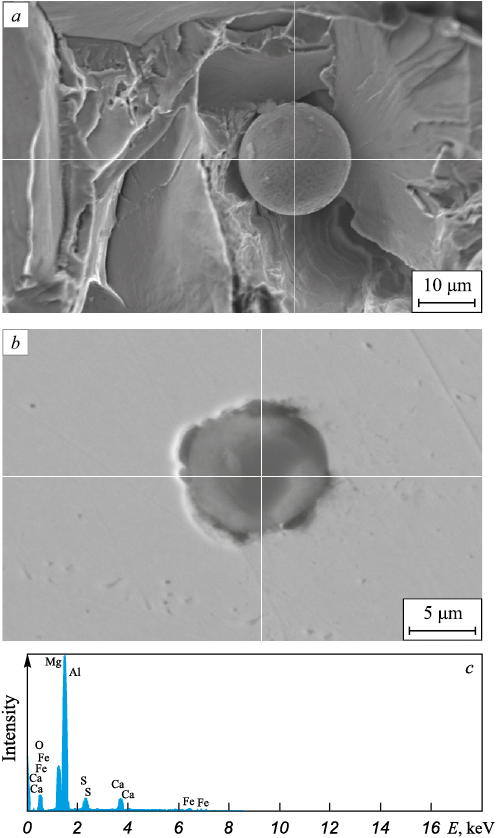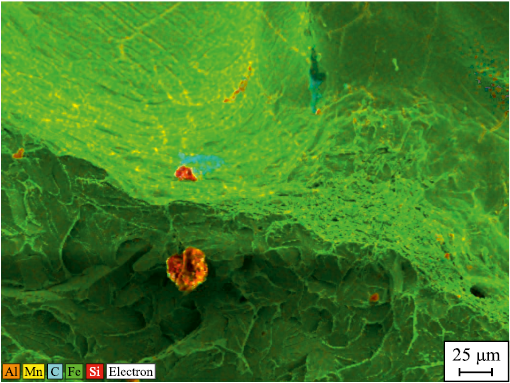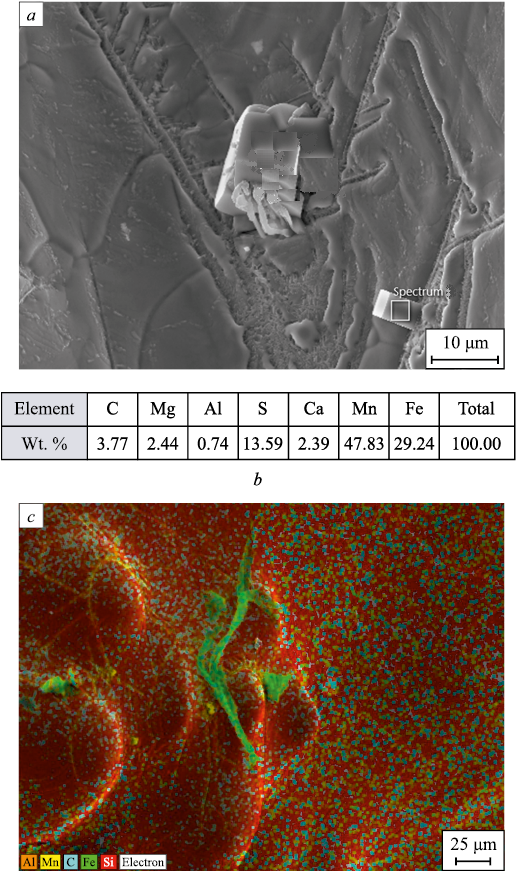Scroll to:
Non-metallic inclusions in micropores of massive steel castings
https://doi.org/10.17073/0368-0797-2025-3-274-279
Abstract
The study of the cast structure of castings makes it possible to optimize the technological parameters of the casting process and improve the quality of cast billets. Electron microscopic studies of nonmetallic inclusions and X-ray spectral analysis of their micro-volumes in metal plates cut from defective sections of a massive casting were carried out. The “fresh” fractures of impact samples with a sharp V-shaped incision destroyed at –60 °C were investigated. It was found that there are practically no oxide films and non-metallic inclusions at the boundaries and in the body of the casting grains. The latter occur on the inner surface of micropores or near them at the edge, and aluminum carbonitrides are present at the grain boundaries or in their body. Determination of chemical composition of non-metallic inclusions in micro-volumes of the order of 1 µm3 allowed us to establish their nature and possible causes of their appearance, as well as formulate practical recommendations for the prevention of visually observable defects in a massive casting. To improve the quality and reduce the number of micropores occurring in the casting, it is necessary to use a cleaner charge that does not contain zinc. Zinc has a low boiling point (907 °C [10]), and, when casting the mold, its vapors, along with other gases, rise to a casting head, under which, as a result of crystallization, they settle in pure form or in the form of ZnO-type compounds on the walls of the resulting micropores, shrinkage porosities, cavities. In addition, it is necessary to remove the slag more carefully so that it does not participate in pores formation, and its particles do not precipitate in or near the pores in the form of magnesia spinel, calcium and manganese sulfides, iron, aluminum, calcium oxides, etc. It is also required to limit the residual aluminum content in steel after its deoxidation to 0.03 %, as is customary in metallurgical production, and to minimize the resin content in the mold material.
Keywords
For citations:
Goikhenberg Yu.N., Kulakov B.A., Polukhin D.S. Non-metallic inclusions in micropores of massive steel castings. Izvestiya. Ferrous Metallurgy. 2025;68(3):274-279. https://doi.org/10.17073/0368-0797-2025-3-274-279
Introduction
The quality of cast parts is a key economic factor not only in the production of castings, but also in their subsequent operation, for example, in the country’s oil and gas sector [1; 2]. Therefore, the study of the cast structure of such castings makes it possible to optimize the technological parameters of the casting process and improve the quality of cast billets [3; 4]. As numerous studies have shown [5], regardless of the casting method or material, defects in castings made of ferrous and non-ferrous metals – such as discontinuities and inclusions – are the main cause of production rejects. Improving the quality of cast steels is directly related to reducing the amount of non-metallic inclusions (NMIs) [6 – 10], as well as understanding their chemical composition, crystalline structure, morphology, location, size, and distribution [11 – 13]. With the advancement of scanning electron microscopy, which enables X-ray spectral analysis in micro-volumes of about 1 µm3, new opportunities have emerged for in-depth studies on the origin and formation of NMIs in steels [14 – 16].
Combining these methods enables identification of the causes of micropore formation that degrades casting quality and development of appropriate mitigation strategies. The relationship between NMIs and micropores is of particular interest as they have a significant impact on the properties of castings. The aim of this study is to investigate NMIs located near and inside micropores in a massive casting, and to develop measures for reducing their number.
Materials and methods
The chemical composition of the studied massive casting (a “housing”) weighing 10 tons without the casting head, as determined from a ladle sample, corresponds to cast microalloyed steel 20GL (GOST 977–88). However, the results of X-ray spectral analysis indicated higher levels of nickel, copper, and zinc. The steel melting process was carried out in an electric arc furnace (EAF) with basic lining and a 25-ton capacity. The molds and cores were produced using the α-set process. It should be noted that during mold filling, the resin binder in the mold and core undergoes thermal decomposition, releasing a large amount of various hydrocarbons, which subsequently, decompose into carbon and hydrogen. The latter promotes formation of gas porosity in the castings [17]. Electron microscopic studies were performed using scanning electron microscopy on the fresh fractures, microstructure, and composition of defective areas in the casting located beneath the casting head, where surface defects are most commonly found. Three billets for impact samples and two billets for preparing longitudinal and transverse microsections were cut from the central areas of the plates that showed no visible cavities. The fresh fractures (examined almost immediately after testing) of impact samples with a sharp V-shaped incision, fractured at –60 °C, were studied on a JSM-7001F scanning electron microscope using secondary electron (SEI) and backscattered electron (BSE) detectors, at magnifications ranging from 30× to 20,000×. The hardness of the metal plates was measured using the HV10 method, with a 10 kg load accuracy. The microstructure was examined and photographed using an Axio Observer.D1m optical microscope. In parallel with the microstructure analysis, the elemental composition of the samples was studied using an OXFORD INCA X-MAX 80 energy-dispersive X-ray spectrometer, both at discrete points and in mapping mode.
Results and discussion
The microstructure of the plates consists predominantly of ferrite and pearlite with varying degrees of dispersion. It also includes a Widmanstätten structure, consistent with the microstructure of 20GL cast steel described in the reference handbook [18]. The hardness of the metal plates varies significantly, ranging from 162 – 181 to 192 – 214 HV10 , while the impact toughness increases from 5.1 – 34.0 to 43.0 – 98.0 J/cm2.
Scanning electron microscopy (SEM) of the fresh fractures revealed a mixed fracture mode in the impact samples with a sharp V-shaped incision, tested at –60 °C. Brittle fracture predominated, accompanied by a minor ductile component and the presence of opened pores (Fig. 1, a). On unetched longitudinal microsections, even at relatively low magnification with an optical microscope, areas containing numerous round or elongated pores of various sizes were observed. Some of these pores contained NMs. The diameters of the pore openings on the external surface ranged from 120 to 130 µm, while the inclusions within them measured between 1.24 and 2.7 µm. A general overview revealed grain boundaries and grain bodies free from inclusions. At higher magnification under SEM (Fig. 1, b), the inclusions were identified as multiphase, and the chemical composition of each phase was determined (Fig. 1, c). For example, the inclusion shown in Fig. 1, b consists of a central region of magnesia spinel (MgO·Al2O3 ) enclosed by a lighter calcium sulfide (CaS) shell – both phases that should have been removed with the slag.
Рис. 1. Photomicrography of the “fresh” fracture of the impact sample – spherical particle |
Microanalysis of the elemental composition in regions containing NMIs, conducted in various modes, enabled the identification of their composition, nature, spatial distribution, and likely causes of their origin. For example, Fig. 2 presents a composite image combining elemental distribution maps for iron, silicon, aluminum, and carbon over an electron micrograph of the inner surface of a micropore. Against the background of the iron matrix (green), particles containing silicon (red), carbon (blue), and aluminum (orange) are observed both within the micropore and in its vicinity. These particles are typically multicomponent rather than monoelemental. A comparison of the silicon and aluminum maps clearly shows that most particles contain both elements. In addition, spectral analysis confirms the presence of oxygen and sulfur in the same region. These elements, along with carbon, are likely gaseous products of thermal decomposition of the resin in the mold, followed by pyrolysis, which releases carbon, oxygen, and sulfur [17]. These gases contribute to pore formation and subsequently condense within them.
Fig. 2. Map of distribution of Fe, Si, C and Al on the micropore inner surface |
In this micropore region, an uneven distribution of aluminum was also observed – either along grain boundaries or as discrete particles (Fig. 3, a). Aluminum frequently forms nitrides with nitrogen, as demonstrated in the corresponding elemental distribution maps (Fig. 3, b, c). In some micropores of impact samples fractured at –60 °C, non-metallic particles of MnS, CaS, MgS, and others that were not removed with slag were also identified (Fig. 4).
Fig. 3. Maps of distribution of Al (a, b) and N (c) in the area of destroyed impact sample
Fig. 4. Electronic image of open micropore (a), |
Scanning electron microscopy of fresh fractures from impact samples cut from other plates revealed, in addition to previously identified NMIs (MgO·Al2O3 , CaS, SiC) located in and around pores, the presence of additional compounds (based on X-ray spectral microanalysis) containing carbon, oxygen, phosphorus (C + O + Ca + Mg + P + Si), as well as magnesium and silicon (C + O + Mg + Si). In one of the plates, near the incision area of the fracture, a region densely populated with particles вcontaining Al, S, and O was found. Some pores also contained compounds such as C + O + S and C + O + Ca while in one pore, particles composed of a wide range of light elements (C + Mg + Al + Si + S + K + Ca + Ti) were detected. Silicon carbides and iron oxides were also detected within the pores. In one of the electron micrographs (Fig. 1, a), a spherical iron oxide particle can be seen being drawn into a micropore. According to the results of X-ray spectral analysis, some small, round precipitates consist of pure zinc or its oxide, ZnO. In complex NMIs, the zinc content ranges from 4.86 to 25.57 wt. % (Table). The location, shape, and size of carbon particles on the inner surface of the micropore are clearly distinguishable (Fig. 4, c). In opened pores, calcium sulfides are sometimes observed surrounded by magnesia spinel, along with aluminum carbonitrides and copper particles.
Results of micro-X-ray spectral analysis of complex NMI in a different pores
|
Conclusions
Scanning electron microscopy of fresh fractures and the microstructure of plates cut from a massive casting showed that oxide films and NMIs are virtually absent at the grain boundaries and within the grain bodies. NMIs were observed primarily inside micropores or near their edges, while aluminum carbonitrides were found along grain boundaries and within the grains. The chemical composition of NMIs, determined by X-ray spectral analysis in micro-volumes of approximately 1 µm3, revealed the presence of carbon, oxygen, sulfur, nitrogen, zinc, and other elements. These findings helped to clarify the nature and likely causes of the inclusions and formed the basis for practical recommendations aimed at preventing visually detectable micropores in massive castings. To reduce the number of NMIs in castings, it is necessary not only to lower the oxygen content by a factor of 2 – 3, as proposed in [19], but also to implement the following measures.
• Use a cleaner charge that is free of zinc during steel melting to prevent its ingress into the melt. Due to its low boiling point (907 °C [20]), zinc vaporizes during mold filling and rises along with other gases toward the casting head, where it condenses during crystallization – either in pure form or as ZnO-type compounds – on the walls of forming micropores, shrinkage porosities, and cavities.
• Remove slag more thoroughly to prevent its involvement in pore formation and deposition of its particles in or near pores in the form of magnesia spinel, calcium and manganese sulfides, and oxides of iron, aluminum, calcium, etc.
• Limit the residual aluminum content in the steel after deoxidation to 0.03 %, as aluminum reacts with nitrogen to form nitrides that precipitate not only along grain boundaries, impeding grain growth and promoting an inherently fine-grained structure, but also within the grains – either as thin plates or as irregularly shaped regions in micropores.
• Avoid overheating the steel melt, as excessive arc temperatures in the furnace promote formation of atomic nitrogen, which dissolves in the molten steel and contributes to the formation of aluminum nitrides and carbonitrides.
• Minimize the resin binder content in the mold material, since excessive resin generates large volumes of gaseous thermal decomposition products (hydrocarbons), which subsequently break down into carbon and hydrogen – promoting formation of gas-related defects such as pores and cavities.
References
1. Kozlov L.Ya., Kolokol’tsev V.M., Vdovin K.I., etc. Production of Steel Castings. Textbook for Universities. Moscow: MISIS; 2003:352. (In Russ.).
2. Shul’te Yu.A. Production of Castings from Steel. Kiev; Donetsk: Vishcha shkola; 1983:184. (In Russ.).
3. Babaskin Yu.V. Structure and Properties of Cast Steel. Kiev: Naukova dumka; 1980:240. (In Russ.).
4. Kazantsev M.N., Flegentov I.A., Zhevelev O.Yu. Quality of cast body parts of shut-off valves and pumps. Oborudovanie i tekhnologii dlya neftegazovogo kompleksa. 2016;(5):8–15. (In Russ.).
5. Chechukha V.I., Sadokha M.A. Defects in high-pressure casting and measures to prevent gas defects. Lit'e i metallurgiya. 2023;(4):16–24. (In Russ.). https://doi.org/10.21122/1683-6065-2023-4-16-24
6. Grigorovich K.V., Krasovskii P.V., Trushnikova A.S. Analysis of non–metallic inclusions as the basis for quality control of steel and alloys. Analitika i kontrol’. 2002;6(2):133–142. (In Russ.).
7. Harris M.L., Richards V.L., Lekakh S., O’Malley R. Evolution of Non-Metallic Inclusions in Foundry Steel Casting Processes: Masters Theses. 2016:22–39.
8. Panichkin A.V., Korotenko R.Yu., Kenzhegulov A.K., Kshibekova B.B., Alibekov Zh.Zh. Porosity and non-metallic inclusions in cast iron produced with a high proportion of scrap. Complex Use of Mineral Resources. 2022;4(323): 68–76. https://doi.org/10.31643/2022/6445.42
9. Li P., Liu D., Pan Zh., Zhang P., Zhang G. Separation of non-metallic inclusions from high strength low alloy steel by electromagnetic stirring. IOP Conference Series: Earth and Environmental Science. 2021;791:012085. https://doi.org/10.1088/1755-1315/791/1/012085
10. Thiele K., Truschner C., Walkner C., Meisel T.C., Ilie S., Rössler R., Michelic S.K. Investigating the origin of non-metallic inclusions in Ti-stabilized ULC steels using different tracing techniques. Metals. 2024;14(1):103. https://doi.org/10.3390/met14010103
11. GOST 1778-2022. Metal products made of steels and alloys. Metallographic methods for the determination of non-metallic inclusions. Moscow: Russian Institute of Standardization; 2023. (In Russ.).
12. Shu’lte Yu.A. Nonmetallic Inclusions in Electrical Steels. Moscow: Metallurgiya; 1964:207. (In Russ.).
13. Kisling R., Lange N. Nonmetallic Inclusions in Steel. Moscow: Metallurgiya; 1968:124. (In Russ.).
14. Gorelik S.S., Skakov Yu.A., Rastorguev L.N. Radiographic and Electron-Optical Analysis. Moscow: MISIS; 1994:328. (In Russ.).
15. Bykov Yu.A., Karpukhin S.D. Scanning electron microscopy and X-ray spectral microanalysis. Equipment, principle of operation, application: Handbook on the course “Modern methods of studying material structure”. Moscow: Bauman STU; 2002:30. (In Russ.).
16. Guo J., Cheng S., Guo H., Yaguan Mail. Determination of non-metallic inclusions in an ingot of continuous casting of steel with an ultra-low carbon content, free of impurities, using the metallographic method, the electrolytic method and the RTO method. Scientific Reports. 2019;9(1):2929. https://doi.org/10.1038/s41598-018-36766-6
17. Boldin A.N., Davydov N.I., Zhukovskii S.S., etc. Cast Molding Materials. Molding, Core Mixtures and Coatings. Reference Book. Moscow: Mashinostroenie; 2006:507. (In Russ.).
18. De Ferri Metallographia: Metallographic Atlas of Iron, Steels and Cast Irons. Vol. II: Schrader A., Rose A. Structure of Steels. Verlag Stahleisen; 1966:559.
19. Krylov S.A., Shcherbakov A.I., Makarov A.A., Tonysheva O.A. Reduction of the content of non-metallic inclusions in corrosion-resistant nitrogen-containing steel. Trudy VIAM. 2017. 2017;53(5):3–13. https://doi.org/10.18577/2307-6046-2017-0-5-1-1
20. Estrin I.A. Analysis from the point of view of energy efficiency of zinc oxide heat technologies. Trudy Rostovskogo gosudarstvennogo universiteta putei soobshcheniya. 2021;(2(55)):147–150.
About the Authors
Yu. N. GoikhenbergRussian Federation
Yurii N. Goikhenberg, Dr. Sci. (Eng.), Senior Researcher, Prof. of the Chair of Materials Science and Physical Chemistry of Materials
76 Lenina Ave., Chelyabinsk 454080, Russian Federation
B. A. Kulakov
Russian Federation
Boris A. Kulakov, Dr. Sci. (Eng.), Prof. of the Chair of Pyrometallurgical and Foundry Technologies
76 Lenina Ave., Chelyabinsk 454080, Russian Federation
D. S. Polukhin
Russian Federation
Dmitrii S. Polukhin, Cand. Sci. (Eng.), Executive Director
8 Eniseiskaya Str., Chelyabinsk 455030, Russian Federation
Review
For citations:
Goikhenberg Yu.N., Kulakov B.A., Polukhin D.S. Non-metallic inclusions in micropores of massive steel castings. Izvestiya. Ferrous Metallurgy. 2025;68(3):274-279. https://doi.org/10.17073/0368-0797-2025-3-274-279




































